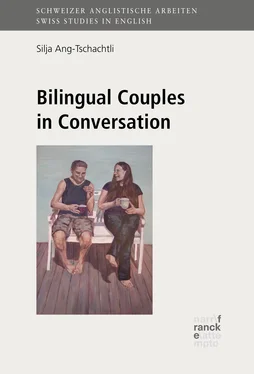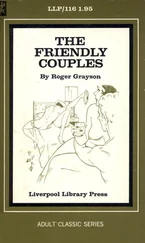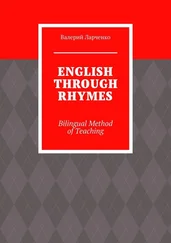Consequently, a bilingual couple’s language is often a complex blend of elements from both partners’ languages. Each partner contributes specific features to the couple language, and as their relationship evolves, so does their couple language. While this occurs unintentionally to some extent, there are also ways in which the partners may actively shape their joint language. Thus, their bilingualism might cause the partners to consciously modify their manner of speaking, for instance by selecting a simpler register or by expressing themselves more clearly or more explicitly. The partners can also make use of their two languages or their bilingualism to create humour, to coin their own expressions, and, ultimately, to generate a distinctive manner of communicating with each other. As a result, partners in a bilingual relationship often perceive their couple language to be unique (Piller 2002a: 224). Thus, in spite of the challenges that are sometimes associated with being a bilingual couple, bilingual partners may also derive benefit from their linguistic situation, as their communicative efforts and their shared code can create a rapport between them or strengthen their sense of togetherness.
There are a number of factors that influence which language or languages partners speak to each other, such as their country of residence, both partners’ language proficiency, their habits, their attitudes, or concerns relating to their personal and couple identityidentitycouple (see section 5.2, “Factors influencing the language choice of bilingual couples”). Due to the multitude of factors affecting the partners’ language choice, a bilingual couple’s linguistic situation is often far from simple or static. Over the course of their lives, various events can occur which may change their mode of communication, and the extent to which they speak both of their languages. They might relocate to a different country, for instance, have children, or become more fluent speakers of their L2.
In the following, I first give an overview of previous work in the areas of bilingual couples’ language use and discuss a number of factors that may influence a couple’s language choice (5.2). I then address the interviewees’ reports of which language(s) they speak to each other, potential situational factors, as well as reasons for their language choice (5.3). Because the partners’ language use outside the home is likely to influence their proficiency, and hence possibly their linguistic behaviour at home, I also comment on their reported language use with other people, and explore the interrelation between the interviewees’ language use outside of and within the relationship (5.4). Furthermore, I discuss two aspects that are reported by several couples to be characteristic about the manner in which they communicate, namely the modification of their speech to suit their bilingual situation, and the achievement of a high level of communication due to their different cultural and linguistic backgrounds (5.5). In the last section of the chapter (5.6), the results are summarized and compared to previous work. On the one hand, this chapter aims to provide insights with regard to the factors influencing the language choices of fluent bilinguals in this specific setting; on the other hand, it gives an overview of the couples’ past and present language use and serves as a basis for the analysis of more specific areas of the couples’ language use in the subsequent chapters.
5.2 Factors influencing the language choice of bilingual couples
5.2.1 Proficiencyproficiency and habithabit
There are many different factors that interact to determine the language choice of a bilingual couple, and it can be difficult to decide which factor is dominant in each situation. One factor that inevitably plays an important role, at least initially, is the partners’ language proficiency. It seems highly likely that a couple will choose the relationship language in which their joint level of language proficiency is the highest. This may be the mother tongue of either of the partners, or a lingua francalingua franca. Beraud, who examined the language use of five Norwegian-Ukrainian bilingual couples, reports that many of them use English as a lingua franca, since this is “the strongest and fairest shared language” for them (2016: para. 1). When examining the language choice and use of German-English bilingual couples living in a number of different countries, Piller also found that language proficiency “is the most basic constraint on language choice” (2002a: 5). Their language choice is possibly linked to the partners’ formal educationlanguage acquisitionformal in each other’s mother tongues, as individuals who have studied their partner’s language at school tend to be more confident about their L2 skills and have a sense of language ownership (Piller 2002a: 99).
As the partners’ language skills evolve, the relationship language may also change. The partners may, for instance, start mixing languages, or using the respective other language in certain situations. However, once a language has been firmly established as a relationship language, habit renders it unlikely that the main language will change. Indeed, many couples in a study by Piller claimed that they use their relationship language out of habit, as it is the language they used when they first met (2000: section 4.2). One reason why habit is an important factor with regard to language choice is that the established language tends to be connected to the couples’ sense of couple identityidentitycouple. Thus, couples often “stick to the language of their first meeting because they might lose the sense of knowing each other, the sense of connectedness and the rapport derived from being able to anticipate what the partner might be about to say if they switched” (Piller 2002a: 138). The language they are accustomed to using — as well as bilingualism itself — may be part of their idea of themselves as a couple. Furthermore, linguistic habits are only likely to change in conjunction with a considerable change in circumstances (Piller 2002a: 140). Since there is a high probability that, for many bilingual couples involving a native speaker of English, including the couples in this study, the language of the first interaction will be English, this frequently becomes their couple language, especially if English also happens to be the community language in their place of residence.
5.2.2 Community languagecommunity language
A factor that is relevant with regard to the partners’ L2 proficiency, and thus potentially also their language choice in the long term, is the community or majority language in the bilingual couple’s country of residence. It is often assumed that the majority language is the natural choice for bilingual couples (Piller 2002a: 133), and that “[i]n mixed marriages there is usually a shift to the majority language” (Romaine 1995: 42). This was confirmed in Piller’s study of 51 couples, which suggested that “the community language is the most powerful indicator of the language bilingual couples will use for marital communication” (2000: section 4.1, para. 5). In a different sample of 36 couples, though, Piller found that only 29.2% of the couples residing in Germany used German with each other, whereas 80% and 40% of the UK and US-based couples respectively used English as their common language, and almost a third of the couples claimed to use a mixed code (2002a: 134). Nonetheless, it seems that couples usually consider the community language the more obvious or preferable choice; Piller reports that the couples in her study who used the minority language or a mixed code “tend[ed] to engage in lengthy discussions, explanations and justifications in their responses”, whereas couples who used the community language rarely did so (2002a: 135). However, there may also be feelings of solidarity towards the less prestigious language (Siguan 1980, in Piller 2002a: 22). Thus, couples might use the non-community languagenon-community language to compensate for the immigrant’s potentially weaker position and attempt to even out the power imbalance to some extent (see also section 3.3.3.1, “L2 Learning and use”).
Читать дальше












